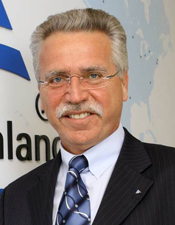May 30, 2012
A Thought Leader Series Piece
By Ralf Wilde
Note: ASU and TÜV Rheinland in 2009 established a commercial joint venture in Tempe, Arizona – the TÜV Rheinland Photovoltaic Testing Laboratory. It is currently the world’s leading provider for PV technology testing.
Our modern definitions of sustainable development have come a long way from the earliest 18th century German paper about sustainable forestry. Over the last 25 years, however, the concept of sustainability has been stretched considerably to encompass a growing number of issues, ideas, and processes.
Sustainability is now at a point where it may be overladen by too many diverse meanings. At the same time, a number of megatrends are exerting their influence on critical sustainability issues, particularly in the areas of energy landscape, urbanization, and scarcity of resources.
This situation has generated calls for a new approach to sustainability that applies rigorous testing and measurement. Implementing such an approach hasn’t been easy.
One challenge is the vast socio-economic variability among regions. Disparities in when and how such different regions employ new products and systems will complicate their quantification and comparison.
A second challenge is the lack of global standards for tools that can assess megatrend-size systems and practices. Without these tools, sustainability will take a back seat to local political values and conventional practices.
A third challenge is the current test and certification landscape, which is characterized by a narrow focus on individual products and services. While this is a huge step ahead from decades ago, we need a more holistic approach for the future. Testing needs to uncover the potential for improvement not only for a product or service under investigation, but also for its related systems.
Demand for conceptually new approaches to sustainability measurement will grow as soon as our economic framework recognizes the value of working toward optimum performance – in other words, doing more with less. This notion is embodied by the “Negawatt,” which compensates energy consumers for reducing their demand through efficiency measures.
To reach optimum performance, a system needs well-designed combinations of resource saving, efficiency improvement, and reduced material and energy intensity. Designers will be better prepared to achieve this goal when they get reliable input regarding best practices, sustainability policies, and market requirements.
There will certainly be no one-size-fits-all solution. Instead, by using agreed-upon key performance indicators within a given product or service segment, we can identify the best designs and uses while sharing information that will expedite further improvements.
Such initiatives are underway. One example is the Electrical Energy Efficiency Certification established by the International Electrotechnical Commission for Electrical Equipment. It stands out because of its cross-border applicability – results from this testing certification process are accepted in most industrial countries of the world.
While the Electrical Energy Efficiency Certification does not uncover the overall sustainability impact of a given product (its primary sustainability-related focus being on energy efficiency in use), it does provide a useful model for global certification.
The next step forward will be to create an international test scheme that connects key performance indicators across entire systems to assess the full sustainability impact of a given product or service. Doing this in a standardized manner will produce the ultimate in real comparability. It will enable understanding that goes beyond just technical and economic parameters to include social and environmental impacts as well.
A critical issue is getting the key performance indicators right. With too much specificity, products won’t interrelate. With too much generalization or qualitative judgment, results will have little meaning. Most importantly, the selected parameters must be clearly and unambiguously defined to ensure that data can be accepted seamlessly among all participating organizations and countries.
We already see the emergence of these kinds of sustainability assessment and certification programs based on international standards, such as TÜV Rheinland’s Green Product Mark for consumer goods. The core value in such assessments is interconnecting data on individual products and services to achieve a systems view with regard to sustainability.
We still have miles to go to resolve all the details, particularly issues over how to balance short-term economic results with long-term environmental and social impacts. Nevertheless, we must continue to push forward. With a standardized systems approach, factual performance information will drive products to continuously improve and become more sustainable than their predecessors.
About the author: Ralf Wilde is the executive vice president for products and a member of the board of management at TÜV Rheinland AG, a leading independent test provider based in Cologne, Germany. The 140-year old company has 500 locations worldwide in 65 countries, including the Tempe-based TÜV Rheinland Photovoltaic Testing Laboratory. An automation engineer with an MBA and doctoral degree, Wilde previously served as president and CEO of TÜV Rheinland in Japan. There he was responsible for developing all of the company’s business activities in the Asia region.


